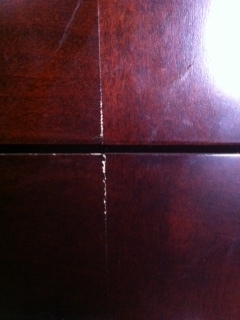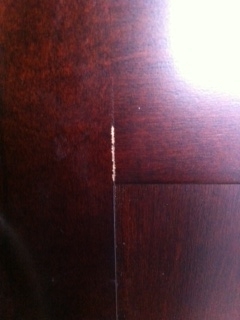Question
I would like some opinions on the photos below. These are Shaker cabinet doors with 3" stiles and rails, made of hard maple. The photos show the joints of the stiles and rails, and as you can see the finish is flaking off. It is typical to see cracking at the joints due to the expansion and contraction of the wood, but I have not seen the finish actually coming off like this. I contacted the finisher and of course he tells me that it's the door manufacturer's fault - that the joints are loose.
There is no indication that they are loose - the joint is tight with no visible gap. We outsource both our doors and our finishing, so I will not be offended by any response. Regardless of whose fault it is we will need to address this for our customer, so I would also be interested in hearing opinions as to what can be done, whether it can be fixed or will need to be stripped and refinished.


Forum Responses
(Finishing Forum)
From contributor R:
It appears to be a finish problem. It's always a tough call, but my guess would be the finish was applied too quick after the stain. The stain will slip down into that joint and get sucked up the end grain, it dries slower there.
My second guess would be (and this might be the case if they've been in use for a long time), the normal breaking of that joint through wood movement (just a small crack in the finish) that would allow moisture to get in if someone used a wet rag often enough. One would see it on the end grain of the doors and the panel joint as well.
A sharp or unbroken edge will give the absolute minimum film build on the edge and that is where the finish will breakdown first, regardless if it's cut or not. However, that is not what happened here. In the photos you have provided it appears that all the failure happens at perpendicular joints. It also appears that the finish is a multi-step spray finish. In my opinion, what happened here is that those particular areas were not sanded absolutely flat in relation to the connecting piece. It does not take a lot of deviation here. The most critical part of finishing is sanding. The most critical part of sanding is touch, plain and simple. Your fingertips can pick up the slightest deviation in joinery, believe me.
So when it was finished there may have been some glue residue or the joinery was off just enough for the film to bridge but ultimately not to last. It's true if those cabinets are wiped down and wetted over time that it will break down the finish at that joint.
I cannot tell from the picture, but those doors do not appear to be brand new. If it were me I would have your finisher try a repair and touch-up at the joints and present it to the client for approval. If the doors are newer then I would have to say sand them back and refinish.
As the wood moves microscopic cracks develop in the finish and allow more moisture into the wood which then accelerates the wood’s movement. Before long the finish can no longer keep up with the movement of the wood and you have finish failure. The only true way to test this hypothesis is to break open a joint where the finish has failed. If it is true that there is not a continuous glue line then the doors will continue to fail and any touchups will also fail in the future.